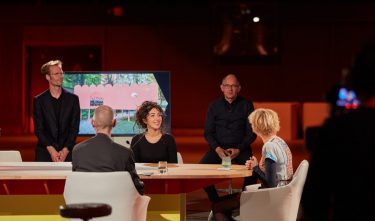It was announced last week that Forum Groningen is the winner of Dutch Design Awards 2020 in the catagory Habitat. Within the framework of Dutch Design Week this year, this column offers another opportunity to consider the three nominated projects and their designers, together and equally.
The three nominations in the Habitat category were assessed in different ways. Firstly, as Dutch representatives of careful and attentive spatial design. A quality that we sometimes take for granted within the luxury of our high-quality, spatially designed country. Each of the projects can also be seen as an echo of the tension that has been building up in recent months, also in the public domain. These projects, however, also directly depict ways out of this and other crises that threaten to hold our society, and the profession of designing in particular, hostage.
The recent period has turned our world upside down, that much is clear. Numerous things and routines we took for granted suddenly disappeared or were replaced by measures and changes stemming from immediate urgency and improvisation. Much of the original care and balance came under pressure as a result. Basic principles were often (temporarily) set aside. Of course, all hand in hand with urgent arguments. After all, needs must.
The effects of the abrupt changes in society are particularly evident in the field of the public domain. The rearrangement of our shops, streets and squares based on the 1.5 meter-measure and with the ‘help’ of all kinds of plastic screens and various Duct tape patterns are the most prominent results of this.
The tension and fear that these symbols impose upon our use and visual experience of (public) spaces almost makes us forget where we have come from and what not so long ago was (the old) normal. A public domain that is shaped and used according to principles like spatial experience, lines of sight, sustainability, social interaction and encounters.
The hope is that many of the improvised measures and changes, however necessary they are, will quickly make place for the original elements and for the quality they deliver. That design and designers can work once again to create spaces that are careful and liveable. On anchor points that are nestled in long-lasting and cherished traditions.
 1
1
 2
2
The three nominated projects for the Habitat category are good examples of such anchor points. Each project, in its own way, stands for clear choices, for quality and for direction. The designers of these projects have taken clear, sometimes hard-won, steps based on the convincing power of design. As such, each project highlights a certain aspect. Whether it is the undiminished value and strength of public places within the urban environment, the importance and emphasis of the necessity for carefully designed learning environments for our children or the beauty of design that draws attention to the disrupted balance between humans and nature. An aspect that, especially now, in today’s controlled and radicalising world, is all too often pushed into the background.
The nominated projects are therefore both a reflection of the distorted reality and a reminder of a world in which design is meaningful, directional and valuable. A world that is in need of attention, maintenance and repair.
The Forum Groningen, the neighbourhood school IKC De Molenwiek and the Paper Gardens exhibition are all examples of careful space. These projects should be cherished, and we, as designers, must keep an eye on the underlying visions. The nomination for the Dutch Design Award 2020 hopefully contributed to this.
JaapJan Berg, DDA jury member and committee chair in the category ‘Habitat’